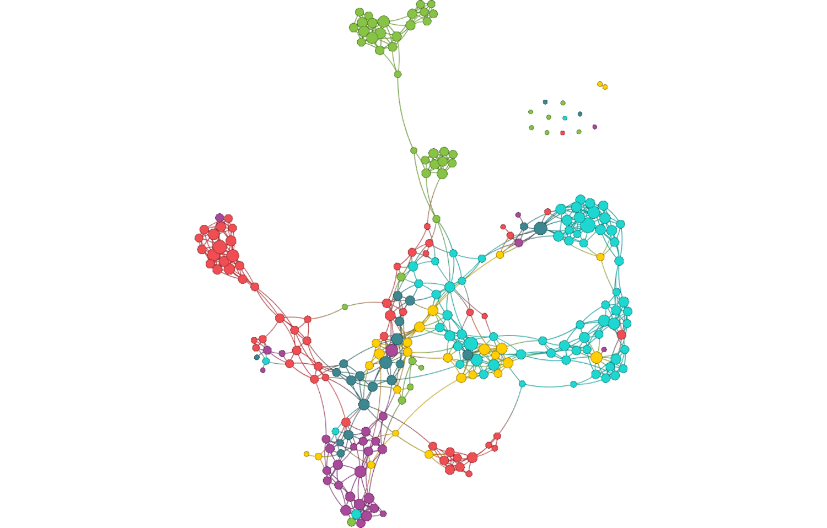Online sustainability discussions have started to shape and influence decisions in politics, business and society. In light of the pandemic, there are an array of international topic experts and vocal thought leaders who have successfully established a steady drumbeat of sustainability-related content while building a breadth of followers and an informed community. But what are the conversations and the topics they care about most?
To learn more from these thought leaders, we compiled a list of the most relevant environmental influencers (economists, business leaders and activists) on Twitter and LinkedIn with over 5,000 followers who are active in both sharing their own content as well as in amplifying posts from the community. We chose to focus on the top seven individuals who received a high level of engagement in the past 12 months.
Below, we have analyzed the content published by these seven thought leaders between January and October 2020 to identify and explore the main topics of conversation covered since the start of the year and throughout the COVID-19 pandemic. Overall, more than 2,300 posts on Twitter and over 250 LinkedIn posts were analyzed within the given timeframe. For privacy reasons, we have anonymized the information and have chosen not to disclose the names of the influencers analyzed.
The analysis has been conducted using Quid, a data visualization tool which searches and clusters the content of blogs and news websites through Natural Language Processing.
Channel comparison
There are notable differences across the two channels analyzed – Twitter and LinkedIn. Through our analysis, we focused on exploring and showcasing, via data visualizations, the variation in content and tone of voice on each of these two channels.
On Twitter: Influencers sing from the same hymn sheet
The below visualization highlights the share of voice of each of the Twitter influencers analyzed through profile-specific colouring. The proximity of the clusters shows the similarities in language and topics, with all influencers focused on how companies have been reacting to the crisis and the importance of ESG investment as they fight against the effects of the pandemic on their employees, customers and bottom line.
A joint action in terms of narrative and language can be seen in this closely connected network. This has a powerful effect on reach and visibility. The main topics of conversation like the call for corporations and governments to take actions are reaching over 159 million people, a remarkably high number.
The most engaged with posts highlight the imperative tone of voice employed by the influencers analyzed, with posts including words like “now”, “immediate”, “it’s time”, “we need” receiving the highest engagements on Twitter.

An overview of the share of voice of the Twitter influencers analyzed.
Each coloured cluster represents the tweets posted by one influencer. Each node represents an individual tweet.

On LinkedIn: Content is very specific and personal to the influencer’s area of expertise
The rather fragmented and less cohesive LinkedIn network shows that each of the analyzed sustainability influencers has a distinct, slightly different personal focus area. These range from climate action or COVID-19 reactions to female empowerment and collaborations in the industry.
The main difference between the content posted by these influencers on Twitter vs LinkedIn is driven by their area of focus. While on Twitter they all contribute to the wider conversation around ESG that is urgent and calls for immediate action from governments and corporates, LinkedIn content offers more space for these influencers to share their opinions on what can be improved, e.g.: companies must advocate for policies to mitigate climate change and what works, e.g.: projects, companies and foundations that are championing change are mentioned and congratulated for their initiatives.
The posts that receive the highest number of interactions (over 2k) are positive in tone and showcase excitement. For example, the most engaged with posts start with words like: “I am proud”, “I am excited”, “congratulations” or signal a personal opinion being shared: “my take”, “my view”.
This highlights the differences between how the two platforms are being used by the same influencers. If Twitter is used to raise awareness and inspire immediate action, LinkedIn is the go-to channel for expressing opinions and sharing personal views (both negative and positive) on sustainability.

An overview of the share of voice of the LinkedIn influencers analyzed.
Each coloured cluster represents the LinkedIn posts published by one influencer. Each node represents an individual post.

Conversational highlights
A demand and call for corporate action
Influencers are expecting and calling for corporates, leaders and politicians to use the COVID-19 pandemic as a catalyst for change and an opportunity to take more responsibility and action towards a better future, especially around fighting climate change.
The conversation around the need for advancement is also frequently mentioned, with all influencers accentuating the positive and insisting on the opportunity at hand to implement changes that can have a real impact on the future.
This can also be seen in the language used. Words like “change”, “action” and “leadership” are very popular and are included in 40% of their posts on Twitter and 25% on LinkedIn.
The below visualizations showcase the share of voice of specific keywords on both Twitter and LinkedIn.

An overview of the share of voice of the most used keywords on Twitter.
Highlighted in blue are the posts using the keywords below: Change, Action & Leadership (40%)


An overview of the share of voice of the most used keywords on LinkedIn.
Highlighted in red are the posts using the keywords below: Change, Action & Leadership (25%)

Diversity and female leadership are dominant
Within the analyzed data, topics such as diversity, inclusion and the power of female leadership are intensely covered. These topics are being linked to the wider conversation around leadership and the need for strong leaders in both politics and businesses. This topic accounts for 50% of the conversation on Twitter and LinkedIn, respectively. These posts also flag the effects of the pandemic on women from bearing the brunt of care responsibilities as schools close and family members fall ill, to being at greater risk of domestic violence and being the most affected by job losses.
The increase in calls for corporations to take action is also supported by findings of the Kekst CNC COVID-19 Tracker Edition 3 (15 June 2020). In a poll conducted by Kekst CNC in June 2020, consumers were asked to choose between environmental, social and governance issues. Whilst all of these topics are interconnected, we found that there has been a shift to the ‘S’ of ESG, with a significant proportion of those polled wanting to see businesses focusing on the measures to help society and people. This is particularly the case in Sweden (53 percent), UK (42 percent), Germany (38 percent) and the US (37 percent).
There is a sector focus on energy and mobility
Energy and mobility are two of the main topics mentioned as opportunities for improvement in a post-pandemic world. These two topics accounted for 11% and 5.5% respectively of total conversations on Twitter. The conversation is focused on the future of mobility and the use of renewable energy, calling for a coal exit.
Within the topic of energy, influencers focused on corporate news (for example, companies are praised for their carbon free goals); research (such as studies on renewable energy); calls from government (for example, regarding coal power plants); and protests (such as against nuclear power plants).
These findings are also supported by the Kekst CNC COVID-19 Tracker Edition 5 (15 September 2020). In a poll conducted by Kekst CNC in September, 35% of consumers polled said they expect that, in a post-pandemic world, the energy industry to be more focused on protecting the environment. Consumers also expect for the energy industry to contribute more to society, according to 21% of respondents. When it comes to what businesses should do in relation to the environment, the priority is on ensuring day to day business activities are environmentally friendly. The latter is particularly relevant for consumers in Germany, Sweden, France and Japan.
Within the topic of mobility, conversations were focused on autonomous driving and e-mobility as well as social mobility. The posts call for an improvement of city living, from forward-looking mobility strategies to improving traffic and public transport.
What this means and the implications for corporate communications
From the analysis of these key influential voices, we can see that there is an increased scrutiny on companies to do more to fight inequality, climate change and champion positive change.
Obviously, first and foremost companies need to establish sustainability efforts that are rooted in their business strategies, backed up by concrete measures and initiatives, and finally summarized in professional data-driven non-financial reporting.
But once this is done, fact-based and tangible strategic communications around all of these efforts is equally essential to convince relevant stakeholders – and credible, vocal thought leaders, who are ready to lift companies that are seen to lead the change.
The following four points should be considered:
Corporate citizenship is a given
As highlighted by our analysis, COVID-19 is widely seen as an opportunity to reimagine and redesign our society – and, consequently, also the corporate world.
Companies should communicate their investments in this space and aim to inform their customers and stakeholders on how they are collaborating with peers, investors, civil society and more to accelerate action toward a clean energy future.
But a convincing DE&I positioning is increasingly considered to be a must have for all corporates
Diversity and inclusion continue to be of paramount importance and one of the key ingredients in creating a better post-pandemic world. Therefore, investing in D&I initiatives and in creating a better, more inclusive workplace is a must. Internal communication and employee advocacy programs and initiatives can help raise awareness of these efforts both internally and externally.
Corporate climate action is a top area of interest being closely monitored
The influencers analyzed demand that companies and organisations take action against climate change and call on corporates to provide information on how they contribute or plan to tackle the problem.
Companies should therefore address climate issues by framing strategy, shaping policy, protecting their reputation, and engaging customers, employees, and markets.
The leadership qualities of those in charge are being closely scrutinized
All influencers analyzed have called for stronger leadership from corporations and governments alike. They have praised the leaders who are taking action and have reprehended the ones who stayed silent.
All companies must find ways to get their employees personally engaged in day-to-day corporate sustainability efforts. This might require a review of narrative, internal and external communication strategies and different ways of thinking about employee engagement via employee advocacy programs.
In summary, this analysis provides additional proof points on the importance of ESG and the need for companies and governments to take action. For our clients, it is clear that the world is watching and the time to lead and create positive change is now.


